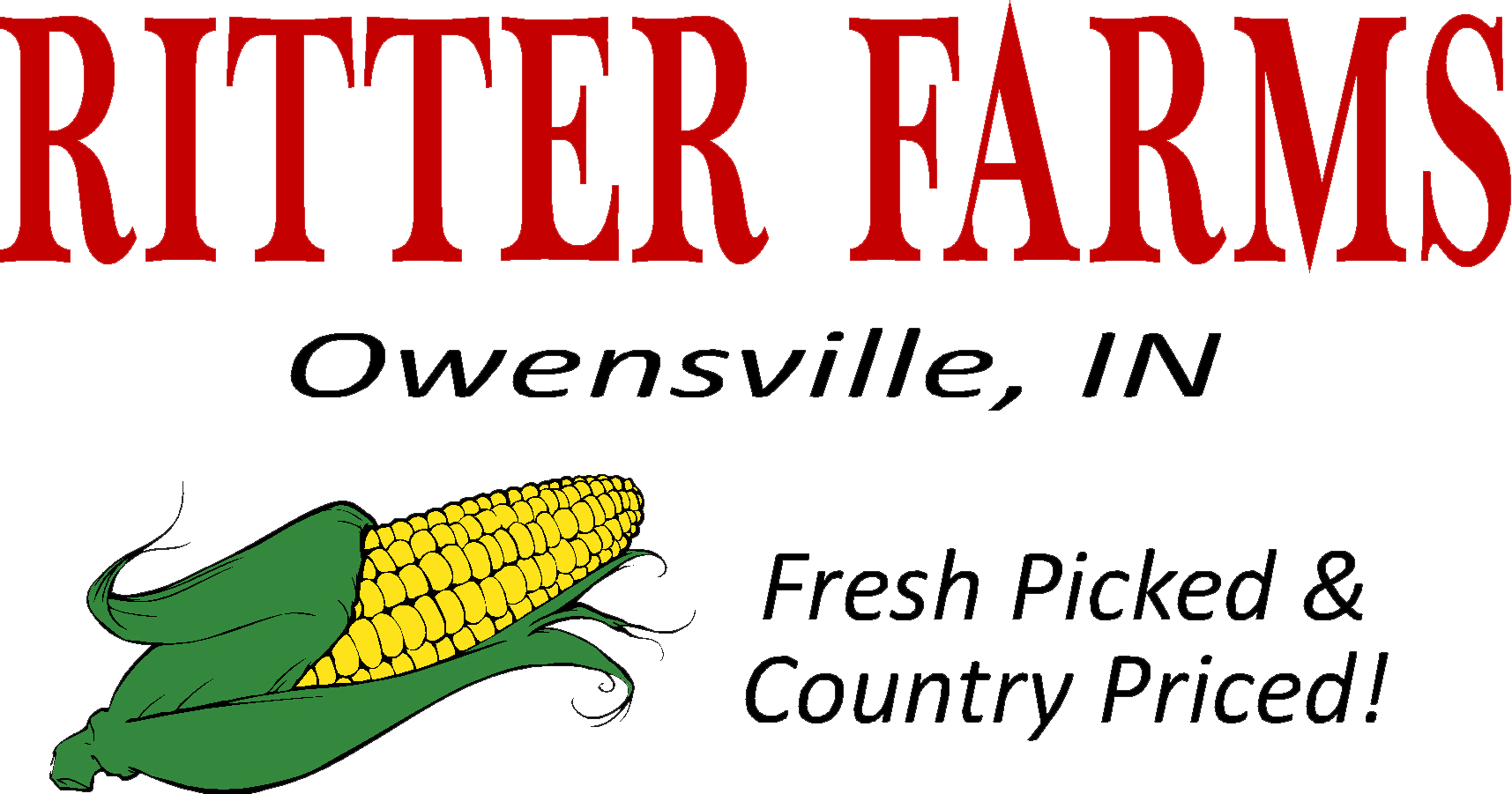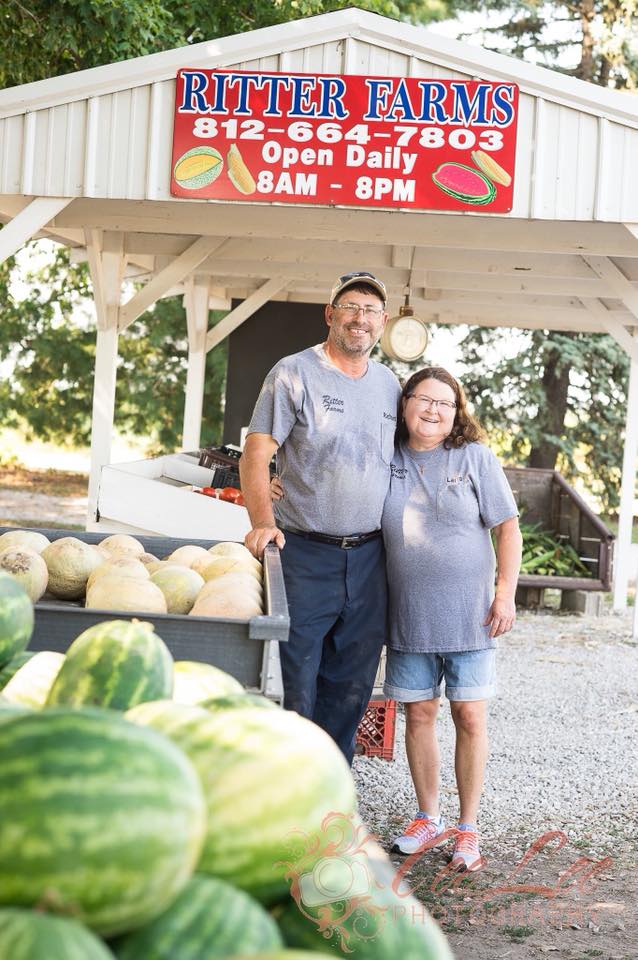
Ritter Farms is a family owned and operated business with a rich history and over 36 years experience and love for farming. Our goal is to always do better and constantly evolve by carefully monitoring every part of the growing and harvesting process.
When Laura and I got married in 1987 we started looking for a house in the country or a piece of property on which to put a home or trailer. We did not have much to spend, but were shown an old farm house on one acre north of Owensville. The structure was built in 1908 and had been home to at least four different families. We were not impressed with the condition of the home or grounds, as there were ruins of several old farm structures dotted throughout the property, and plenty of scrubby trees growing up making it look rough. But the price was right, and with a baby on the way later that year, we needed to find a house soon. As it turns out, there were an additional 21 acres adjacent to the house also for sale, which had all been part of the original farm. The soil was half dry sand and half low lying wet ground that had been left to nature, presumably because previous farmers got tired of pulling their equipment out of the mud in what was now seven acres of white ash woodlot. So the price of the land was low enough that even a poor farm boy with a beginning teacher’s salary could actually make an offer to buy it. Looking back we realize that the acquisition of this property, which had been on the market for too long already, was nothing short of a blessing straight from the hand of God. After a few years of dabbling in hogs and renting out most of the tillable land, we got the idea to try our hand at watermelons. After all, most of the neighbors grew melons. It’s what you do with sandy ground in Gibson County. We put out an acre, with the help of some neighbors, and amazingly made enough money to put new carpet in the living room. Say, there may be something to this produce farming! Having grown up on a cattle and grain farm and being a Purdue trained agriculturist, it was only natural that I wanted us to explore getting into the farm produce business. I might actually have a chance to call myself a farmer, instead of just teaching about it as the agriculture instructor at Gibson Southern High School. We started off very slowly while the four children were toddlers, but it wasn’t long before we grew some sweet corn, cantaloupes, and tomatoes to try to sell. I still remember how excited I was when someone actually stopped out front of the house and bought something. I could not believe people would actually pay for something as common as a tomato! I think our first price was six tomatoes for a dollar! My Wife, Laura, had worked in her father’s drug store in Fort Branch, so we got the idea to set up a small table of produce on the sidewalk in front of the store. The clerks didn’t seem to mind taking the money for us, and I am sure we provided them some goodies now and then in exchange for their help. Of course many thanks to Bob and Pat Garbers for allowing us to peddle our produce at their store. I had built a sturdy five foot long display table to put in front of the store. It was made of rough cut oak from the sawmill, back when one could still acquire lumber like that. The table is now retired from holding big piles of melons and corn, yet it sits proudly in front of the roadside stand greeting folks, holding bags for shoppers and dispensing pens, scratch pads, and business cards.
We knew there was lots of produce grown in Gibson County, but it was clear to us that not all produce is created equal. I had grown sweetcorn as a kid and helped my mother sell excess garden produce, mostly to very grateful older folks who enjoyed our visits as much as the vegetables. I even talked with Mom about how we could start a truck patch some day and make some money. But I never dreamed that we would have a full time business with all the wonderful patrons that we have today. We eventually moved the stand to our front yard, but did not stop there. Over the years we sold produce off of a trailer at a gas station a few days a week. We would take orders and deliver on occasion. We would fill the trunk of the car with cantaloupes and sell them door to door in the subdivisions. Then there were the farmer’s markets we attended. At one point we went to three markets per week, all of which helped people know who we were and where to get some good sweetcorn! The basic principles we decided on to set our produce apart are just common sense. We wanted to find the best tasting varieties, not necessarily the ones the big growers used to ship all over the country. We also insisted on our produce being picked fresh every day, and not making it sit there until sold. This has made for some happy cows along the way, as they are the beneficiaries of any leftovers. If you want to see a cow smile, just feed it a cantaloupe! Another secret we practice is to pick the produce in its prime. Let the tomatoes get ripe on the vine. Keep the squash picked off before it gets too big. Pick only the young and tender ears of corn. Really just basic ideas, but it takes more work in real life. Lastly, we wanted to keep the prices low. We started selling produce just for supplemental income, and did not have to depend on it for a living. It’s a low overhead business. We like it that way. There are few stores where the total due is less than expected. I have always hoped people will feel that way at our farm stand. Through the years the farm has provided for our family very many blessings. It has helped teach the children to work and helped them through college. It has allowed us to invest in sufficient equipment and buildings that it can be considered a proper farm. It has provided funds to take vacations with the grandkids. Now as we are retired from our regular jobs, it provides supplemental income and part time work for the grandkids. Of course it also provides the opportunity to meet many nice people who start as customers but soon become friends!

